While I was going on the UNESCO World Heritage City in Georgetown, I found these bunga telang or clitoria flowers drying under the sun. It has been a while since I see these lovely flowers. When I was small, I used to help the grandma from next door to pluck the flowers every morning and these will be dried in the sun.
These flowers are used as natural food dye and the blue colour looks really lovely in foods. Do you know that blue colour cakes or kueh are rarely used by the Chinese? Therefore, only two types of kueh use the blue dye.
Blue colour denotes mourning and at funerals, they do offer blue and white kuehs to the deceased soul. So, never make any traditional kueh in blue colour and offer it to some elderly person, if you can help it.
Let’s see some of the uses of the bunga telang.
This is a packet of nasi kerabu I bought from a pasar malam in Kota Bahru, Kelantan if I remember correctly. However, I doubt they use the authentic bunga telang to colour the rice.
Meanwhile, the above is the pulut inti. This is the real colour of the bunga telang. I am not too sure how they turn the flowers into food dyes but I guess they probably soak the dried flowers in water to steep and get the blue colour. Then, they soak the rice in the blue water. Pulut inti is made by steaming the sticky rice with coconut milk. The brownish blob is the grated coconut cooked in brown sugar.
This is my all time favourite Malaysian kueh. The pulut ta tai. The method of making it is almost similar to pulut inti. But the steamed rice are compacted and then, cut into rectangles. The brownish jam is the seri kaya or coconut jam. It is made of double boiling coconut milk, sugar and eggs for a long time.
I hope people will continue to plant this creeper plant of the clitoria flowers and keep the tradition of using natural food dye. I love the romance of white picket fence with bunga telang flowers adorning the garden. If only I have a house in a kampong….
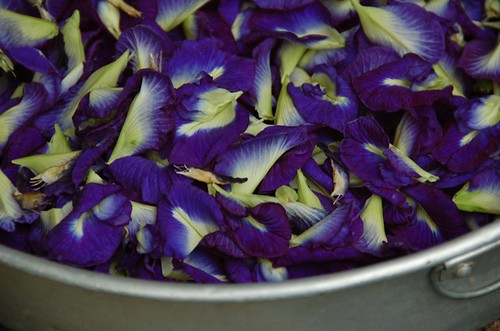
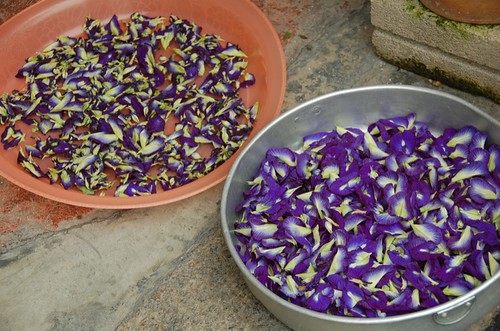
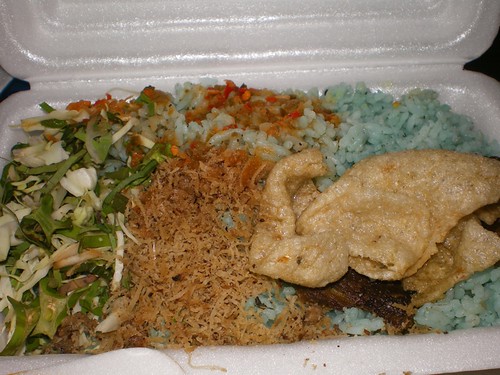
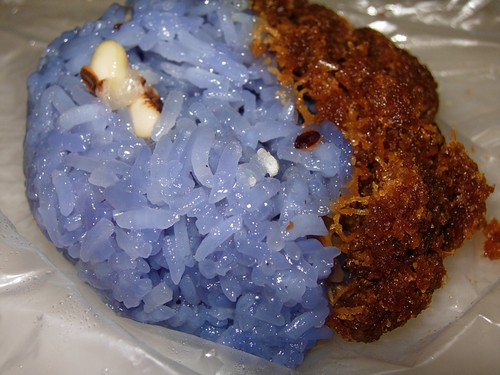
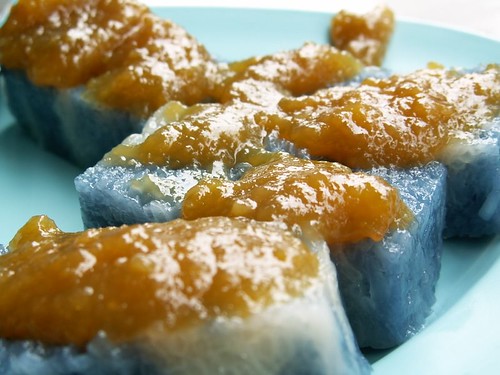
wow! never seen this flowers. never know the usage. thanks for the info 🙂
pulut ta tai is my favorite kueh too… no one dare to grab single one from my plate… haha…
Whew! that was a natural nice keuh; looks naturally yummy…
My Grandma used to collect Bunga Telang flowers, she would rinsed the flowers to get rid of whatever dirt. Then blot it dry and plucked the petals until she gets about a cup or 1 1/2 cup of the petals. She would then pound the petals finely in her old reliable mortar and pestle. Do not add any water, after which when it is finely pounded sqeeze hard with your fingers to extract the juice. After all the hardwork, you can only get a tablespoon of the indigo colour juice!
Actually, you don’t need to live in a kampong to have bunga telang, I live in Subang Jaya, in a terrace house and I have bunga telang growing on my fence! They grow really really fast, faster than weeds! Actually you don’t need a fence, you can just grow it on the ground, it won’t creep so much if there is no place for it to ‘climb’. However, you won’t get as many flowers. If anyone wants a plant, feel free to let me know (self collection-lah).
Oh.. I didn’t know that kueh is called Pulut Ta Tai.. I just call blue color cake with kaya lol. Used to eat it when I was small as breakfast.. it has been years since I last ate one..
[…] I turned to local writer and cooking teacher, Linda Tay Esposito, for a small handful of bunga telang, the petals of dried clitoria flowers that are used to color sweet rice and other desserts in […]